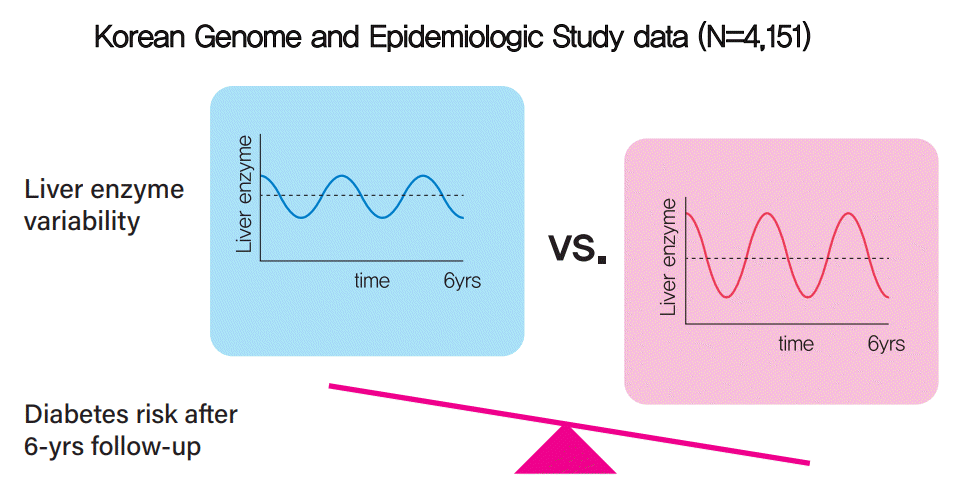INTRODUCTION
METHODS
Study population
Clinical and biochemical parameters
Definitions
Statistical analysis
RESULTS
Table 1.
Values are presented as mean±standard deviation or number (%). To convert glucose level to millimoles per liter, multiply by 0.0555. To convert insulin level to picomoles per liter, multiply by 6.945. To convert total, low-density lipoprotein cholesterol, and HDL-C levels to millimoles per liter, multiply by 0.0259. To convert triglyceride level to millimoles per liter, multiply by 0.0113.
HOMA-IR, homeostasis model assessment of insulin resistance; HDL-C, high-density lipoprotein cholesterol.
Table 2.
HR for continuous variables are shown as 1-SD increment.
HR, hazard ratio; CI, confidence interval; HOMA-IR, homeostasis model assessment of insulin resistance; HDL-C, high-density lipoprotein cholesterol; SD, standard deviation; CV, coefficient of variation; ASV, average successive variability; VIM, variability independent of the mean.
Table 3.
|
Total (n=4,151) |
Heavy alcohol drinker (–) (n=3,741) |
Heavy alcohol drinker (+) (n=388) |
|||||
|---|---|---|---|---|---|---|---|
| AST | ALT | AST | ALT | AST | ALT | ||
| Model I | SD | 1.05 (1.00–1.10)a | 1.03 (0.97–1.09) | 1.02 (0.95–1.10) | 1.00 (0.91–1.10) | 1.36 (1.20–1.54)b | 1.47 (1.24–1.75)b |
| CV | 1.12 (1.05–1.20)c | 1.03 (0.95–1.11) | 1.08 (1.00–1.17) | 1.00 (0.91–1.09) | 1.55 (1.27–1.89)b | 1.38 (1.11–1.72)c | |
| ASV | 1.04 (0.99–1.09) | 1.03 (0.97–1.08) | 1.01 (0.94–1.09) | 1.00 (0.92–1.10) | 1.38 (1.21–1.58)b | 1.44 (1.21–1.70)b | |
| VIM | 1.10 (1.01–1.19)a | 0.97 (0.89–1.06) | 1.08 (0.99–1.17) | 0.96 (0.87–1.05) | 1.35 (1.07–1.69)a | 1.22 (0.97–1.54) | |
| Model II | SD | 1.06 (1.01–1.11)a | 1.03 (0.98–1.09) | 1.03 (0.96–1.10) | 1.01 (0.93–1.10) | 1.39 (1.23–1.57)b | 1.58 (1.33–1.88)b |
| CV | 1.14 (1.06–1.22)b | 1.04 (0.96–1.13) | 1.09 (1.01–1.18)a | 1.10 (1.00–1.21) | 1.59 (1.31–1.93)b | 1.44 (1.15–1.79)c | |
| ASV | 1.05 (1.00–1.09) | 1.03 (0.98–1.09) | 1.02 (0.94–1.10) | 1.01 (0.93–1.10) | 1.40 (1.22–1.61)b | 1.50 (1.27–1.77)b | |
| VIM | 1.13 (1.04–1.22)c | 0.99 (0.91–1.08) | 1.10 (1.01–1.20)a | 0.97 (0.88–1.06) | 1.42 (1.13–1.78)c | 1.23 (0.97–1.56) | |
| Model III | SD | 1.06 (1.00–1.11)a | 1.01 (0.92–1.10) | 1.02 (0.94–1.11) | 0.94 (0.80–1.10) | 1.44 (1.22–1.71)b | 1.57 (1.26–1.94)b |
| CV | 1.12 (1.04–1.21)c | 1.01 (0.92–1.10) | 1.08 (0.99–1.17) | 0.97 (0.88–1.07) | 1.60 (1.31–1.97)b | 1.39 (1.09–1.76)c | |
| ASV | 1.04 (0.99–1.10) | 1.02 (0.94–1.10) | 1.01 (0.92–1.11) | 0.95 (0.81–1.12) | 1.55 (1.28–1.88)b | 1.53 (1.25–1.89)b | |
| VIM | 1.13 (1.04–1.22)c | 0.99 (0.91–1.09) | 1.10 (1.01–1.20)a | 0.97 (0.88–1.06) | 1.49 (1.18–1.87)c | 1.25 (0.97–1.62) | |
| Model IV | SD | 1.04 (0.93–1.17) | 0.94 (0.81–1.10) | 1.04 (0.91–1.20) | 0.90 (0.72–1.12) | 2.04 (1.15–3.61)a | 1.55 (1.07–2.23)a |
| CV | 1.11 (1.02–1.22)a | 0.99 (0.90–1.09) | 1.10 (1.00–1.21) | 0.97 (0.88–1.08) | 1.57 (1.17–2.13)c | 1.26 (0.97–1.63) | |
| ASV | 1.03 (0.92–1.14) | 0.96 (0.84–1.11) | 1.02 (0.88–1.18) | 0.91 (0.72–1.15) | 1.77 (1.18–2.67)c | 1.53 (1.11–2.11)a | |
| VIM | 1.11 (1.03–1.21)a | 0.99 (0.90–1.08) | 1.10 (1.01–1.20)a | 0.97 (0.88–1.07) | 1.46 (1.15–1.85)c | 1.28 (1.00–1.65) | |
Values are presented as 1-SD increment and 95% confidence interval. Information on alcohol consumption was identified in 4,129 subjects. Model I: no adjustment; Model II: adjusted for age and sex; Model III: Model II+adjusted for body mass index, waist circumference, systolic blood pressure, high-density lipoprotein cholesterol, triglycerides, fasting insulin, fasting glucose, 2-hour post-load glucose, hypertension, and hyperlipidemia; Model IV: Model III+adjusted for mean AST or ALT.
AST, aspartate aminotransferase; ALT, alanine aminotransferase; SD, standard deviation; CV, coefficient of variation; ASV, average successive variability; VIM, variability independent of the mean.
Table 4.
|
Insulin secretion indices |
Insulin sensitivity indices |
Inflammatory markers |
|||||
|---|---|---|---|---|---|---|---|
| HOMA-B% | IGI60 | Disposition index | HOMA-IR | ISI | White blood cell count | hsCRP | |
| AST | |||||||
| SD | –0.01 | –0.04a | –0.08b | 0.11b | –0.09b | 0.07b | 0.10b |
| CV | 0.00 | –0.03c | –0.06b | 0.09b | –0.06b | 0.06b | 0.07b |
| ASV | –0.01 | –0.04a | –0.07b | 0.11b | –0.08b | 0.07b | 0.10b |
| VIM | 0.01 | –0.01 | –0.02 | 0.05b | –0.02 | 0.04a | 0.02 |
| ALT | |||||||
| SD | 0.01 | 0.01 | –0.09b | 0.23b | –0.23b | 0.10b | 0.14b |
| CV | 0.04a | 0.00 | –0.05b | 0.12b | –0.10b | 0.04a | 0.07b |
| ASV | 0.01 | 0.01 | –0.09b | 0.22b | –0.21b | 0.09b | 0.13b |
| VIM | 0.05b | 0.00 | –0.01 | 0.01 | 0.00 | –0.01 | 0.01 |
HOMA-B%, homeostasis model assessment of β-cell function; IGI, insulinogenic index; HOMA-IR, homeostasis model assessment of insulin resistance; ISI, insulin sensitivity index; hsCRP, high-sensitivity C-reactive protein; AST, aspartate aminotransferase; SD, standard deviation; CV, coefficient of variation; ASV, average successive variability; VIM, variability independent of the mean; ALT, alanine aminotransferase.




 PDF
PDF Citation
Citation Print
Print




 XML Download
XML Download